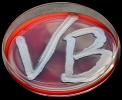| Species/Subspecies: | Pasteurella multocida subsp. multocida | ||||||||||||||||||||||||||||||||||||||||
|---|---|---|---|---|---|---|---|---|---|---|---|---|---|---|---|---|---|---|---|---|---|---|---|---|---|---|---|---|---|---|---|---|---|---|---|---|---|---|---|---|---|
| Categories: | Zoonotic; notifiable diseases and bacteria | ||||||||||||||||||||||||||||||||||||||||
| Etymology: | Genus name: named after Louis Pasteur. Species epithet: a lot of killing. Subspecies epithet: see Species epithet. | ||||||||||||||||||||||||||||||||||||||||
| Significance: | [Very important] | ||||||||||||||||||||||||||||||||||||||||
| Taxonomy: | Class Gammaproteobacteria Order Pasteurellales Family Pasteurellaceae Genus Pasteurella |
||||||||||||||||||||||||||||||||||||||||
| Type Strain: | ATCC 43137 = CCUG 17976 B och 43504 = NCTC 10322. | ||||||||||||||||||||||||||||||||||||||||
| Macromorphology (smell):
| Small mucoid or dry colonies (1-2 mm in diameter). No hemolysis on blood agar, but some strains give a greenish decolorization. | ||||||||||||||||||||||||||||||||||||||||
| Micromorphology: | Small non-motile short rods or coccoid rods (0.3-1.0 x 1.0-2.0 µm), which appear singly, in pairs or as short chains (rarely). | ||||||||||||||||||||||||||||||||||||||||
| Gram +/Gram -: | G- | ||||||||||||||||||||||||||||||||||||||||
| Metabolism: | Facultatively anaerobic | ||||||||||||||||||||||||||||||||||||||||
| Catalase/Oxidase: | +/(+) | ||||||||||||||||||||||||||||||||||||||||
| Other Enzymes: | Ornithine decarboxylase +, tryptophanase + (= indole +), urease -. | ||||||||||||||||||||||||||||||||||||||||
| Biochemical Tests: | Citrate -, hydrogen sulphid (H2S) -, methyl red -, Voges-Proskauer -. | ||||||||||||||||||||||||||||||||||||||||
| Fermentation of carbohydrates: | D-glucose + lactose - maltose - L-rhamnose - sucrose + L-arabinose - cellobiose - D-mannitol + salicin - trehalose + glycerol v inulin - raffinose - D-sorbitol + starch ? Gas production: Glucose -. |
||||||||||||||||||||||||||||||||||||||||
| Spec. Char.: | |||||||||||||||||||||||||||||||||||||||||
| Special Media: | |||||||||||||||||||||||||||||||||||||||||
| Disease: |
|
||||||||||||||||||||||||||||||||||||||||
| Virulence Factors: | Dermonecrotic toxines of P. multocida subsp. multocida of capsular type A and D, which causes atrophic rhinitis in pig. | ||||||||||||||||||||||||||||||||||||||||
| Genome Sequence: |
|
||||||||||||||||||||||||||||||||||||||||
| 16S rRNA Seq.: |
| ||||||||||||||||||||||||||||||||||||||||
| Taxonomy/phylogeny:
|
About 12 species have been described within genus Pasteurella, but the relationship between members within the closely related genera Actinobacillus, Haemophilus, Mannheimia and Pasteurella is very uncertain since none of these genera forms monophyletic clusters. | ||||||||||||||||||||||||||||||||||||||||
| Comment: | Atrophic rhinitis is notifiable in Sweden. Pasteurella infections may be zoonotic and associated with cat bites. Fermentation of D-sorbitol and trehalose can be used for identification of subspecies. | ||||||||||||||||||||||||||||||||||||||||
| Updated: | 2024-10-23 |
